Introduction
Do students learn how to write by participating in disciplinary discourse communities and learning the appropriate language, style, genres, and forms of argument? Or do students actually need to learn to participate in more complex, less homogeneous communities of practice or activity systems? And is what students are learning just writing? And is where students are learning limited to schools and eventually disciplinary spaces (universities, research labs, field sites, etc.)? These questions, as I reflect in the video below, have been at the heart of my work over the last three decades and the answers I have arrived at so far are the focus of my contribution to Making Future Matters.
Opening his influential article on temporal scales and development, Jay Lemke asked two key questions: "How do moments add up to lives? How do our shared moments together add up to social life as such" ("Across the Scales of Time"). These questions should be at the center of our thinking about how writing and literate practices develop across the lifespan and how school literacy instruction and other domains of social practice fit into the long arc of human becoming.
However, much research, theory, and practice have been grounded in what I call "tales of learning." A tale of learning says that learning happens inside specific territorial communities, each of which owns its own space of knowledge and discourse. Novices must enter these magic circles as individuals and make their way to the centers (or fail to do so) by moving step-by-step along a sequentially graded curricular path. Tales of learning have also bought into the folk model of four modes: reading, writing, speaking, and listening. The Common Core Standards Initiative and, for the domain of science, the Next Generation Science Standards are epitomes of the tale-of-learning vision.
The NextGen standards argue that moments add up to scientific lives step-by-step along a path made up of eight core practices:
The eight practices of science and engineering that the framework identifies as essential for all students to learn, and describe in detail, are listed below:
- Asking questions (for science) and defining problems (for engineering)
- Developing and using models
- Planning and carrying out investigations
- Analyzing and interpreting data
- Using mathematics and computational thinking
- Constructing explanations (for science) and designing solutions (for engineering)
- Engaging in argument from evidence
- Obtaining, evaluating, and communicating information (Next Generation Science Standards, vol. 2: 48)
To get a sense of the sequentially, graded character of this tale of learning, consider the way NextGen lays out practice number 7 across four increasingly elaborated stages defined by the contemporary sociocultural organization of schooling (e.g., the third stage, grades 6–8 points to middle schools, a relatively recent historical innovation in the United States).
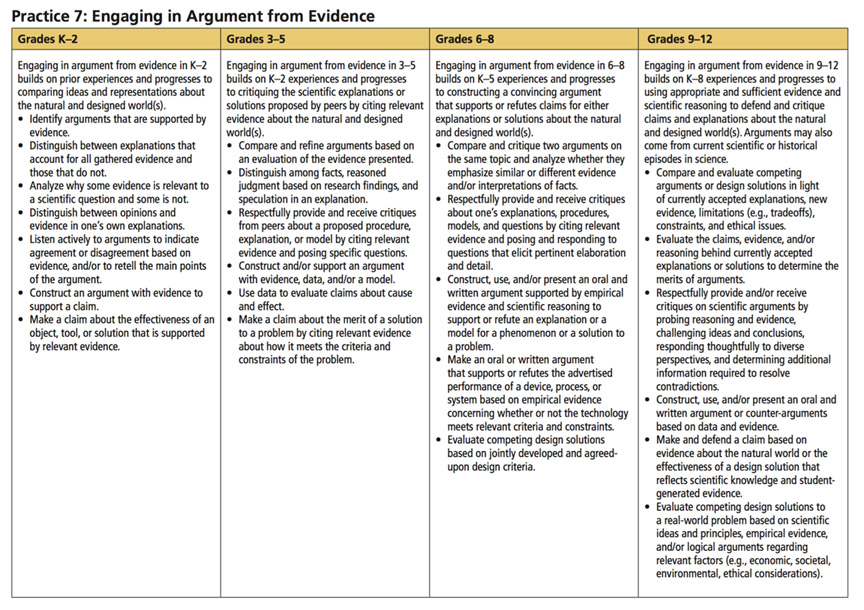

It is also worth noting that the practices typically either ignore semiotics or specify one of the four modes. This table laying out how students are supposed to learn to engage in argument notes, for example, that in grades 3–5 students should "compare and refine arguments based on an evaluation of the evidence presented" while in grades 6–8, they should "compare and critique two arguments on the same topic and analyze whether they emphasize similar or different evidence and/or interpretations of facts." These statements don’t identify whether the arguments are encountered as talk, text, mathematics, visual representation, or some blend or what semiotics are produced in order to refine and critique. They don’t say anything about whose arguments are being evaluated or how students might engage with the evidence (e.g., through their own inquiry or not, individually or in groups). Lower down the bulleted lists, students in grades 6–8 are supposed to "construct, use, and/or present an oral and written argument supported by empirical evidence and scientific reasoning to support or refute an explanation or a model for a phenomenon or a solution to a problem," while those in grades 9–12 are to "construct, use, and/or present written argument or counter-arguments based on data and evidence." Across all the levels attention to the routine multimodality of arguments (i.e., the way they are achieved through coordination of multiple semiotic resources) is absent.
In contrast, the story I am calling "a trajectory of semiotic becoming" sees learning as embodied, dispersed, mediated, laminated, and deeply dialogic. Becoming happens not inside domains, but across the many moments of a life. Becoming happens in spaces that are never pure or settled, where discourses and knowledge are necessarily heterogeneous, and where multiple semiotic resources are so deeply entangled that distinct modes simply don't make sense.
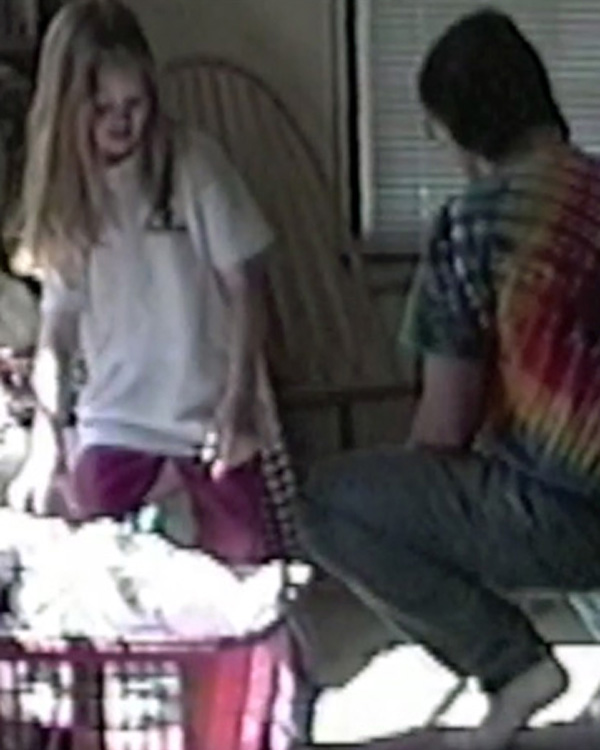
Here are two images (moments) in a trajectory of semiotic becoming, a life. The first image is our daughter, Nora, at age 8 folding clothes and playing a pretend game ("Cindy Magic") with me and her sister. "Cindy Magic" emerged from a game that Nora and I co-developed when she was three and a half during a long car ride to address how disturbing she found Cruella de Vil in the Disney animated movie101 Dalmatians. Initially, Nora played Cruella Magic, a hero who found lost and kidnapped baby animals and reunited them with a parent (my role in the game), who would joyfully thank her. Four years later we were playing in a much more developed imaginary world, where Cindy Magic (sister to Cruella Magic, the original character to challenge Cruella de Vil) is again at battle with Cruella de Vil. My partner and Nora's mom, Julie Hengst, began researching Cindy Magic as a seminar project during her PhD studies in order to explore Goffman's notions of footings (128), and we have both found the interactional data of me playing the game with Nora and her sister, Anna, theoretically and methodologically illuminating (Hengst and Miller; Hengst; Prior, et al., “I’ll Be the Sun”). The second image is Nora at 25, then a PhD student in zoology at the University of British Columbia. She is doing field work near the Fowler's Gap Arid Research Station in New South Wales, Australia: holding a zebra finch, banding the bird, adding an RFID tag under its skin for tracking in the wild, taking a blood sample for other researchers' genetic analysis, recording the details of this interaction in a notebook, and labeling and placing blood samples in a green micro-centrifuge tube tray. I see a coherent arc across these moments that add up to Nora's ways of being-in-the-world as a person and a biologist.
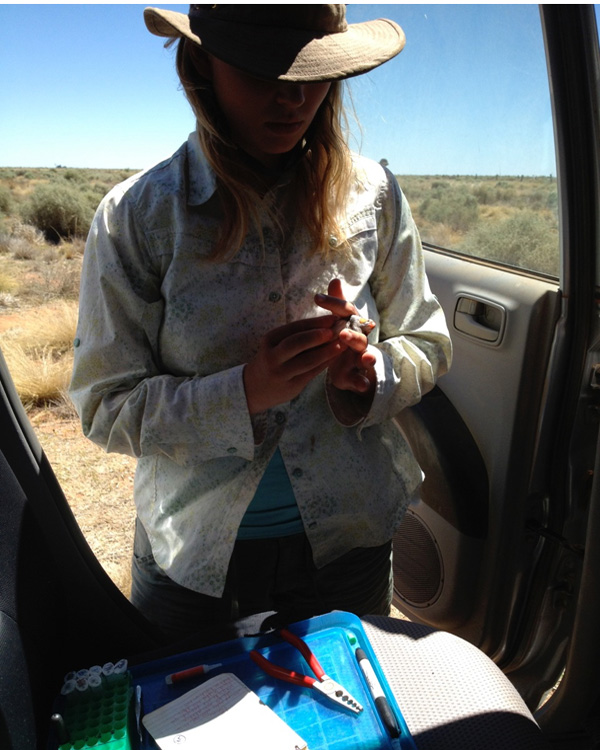
Here are another pair of images that index textual dimensions of this developmental trajectory.
First is an image from Nora's fourth grade (1996) report on jaguarundis, a topic she chose when asked to do a research paper. She noted in a text-based interview:
my big memory is like that it didn't have to be about animals, you know, it was just a research paper. Animals were really important to me. Like a vague feeling that, that like at the time people weren't very interested about the environment in school, so it wasn't really seen as like, I don't know, very interesting.
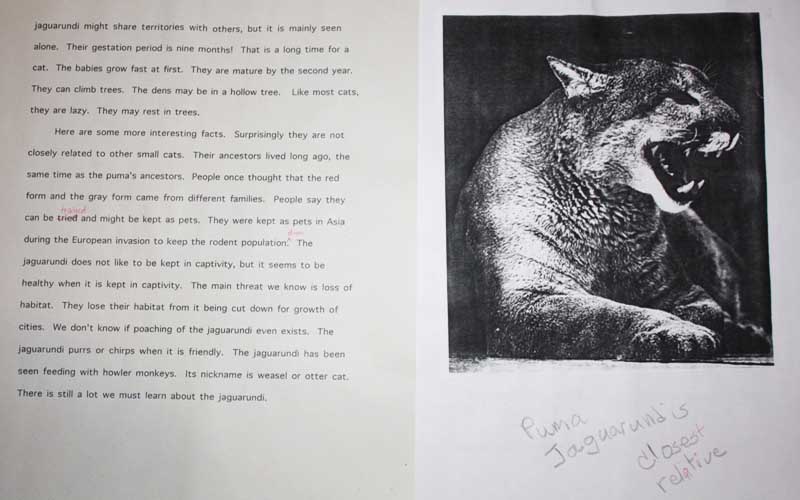

It includes a downloaded image of a puma, print text, and handwritten text from Nora (and two line edits in red from her teacher). The report itself was written in an informational style and included a bibliography with 8 sources (mostly popular science texts about animals, wildlife, or cats). The second is an image from a review article, "Neuroendocrine regulation of long-term pair maintenance in the monogamous zebra finch," that Nora co-authored with her PhD advisor and that was published in the journal Hormones and Behavior (Prior and Soma 19). Figure 5 (near the end of the article) is not a standard representation of brain regions but a visual-textual, and often metonymic, summary of findings from the review and a mapped argument for potential future research. For example, the red stars show areas with receptors for aromatase (an enzyme involved in production of estrogen) and estrogen to highlight the possibility that sex steroids may interact with other signaling molecules in the zebra finch brain. The caption includes 10 citations from among the 130 works cited in the review (mostly other technical, peer-reviewed science articles in English).
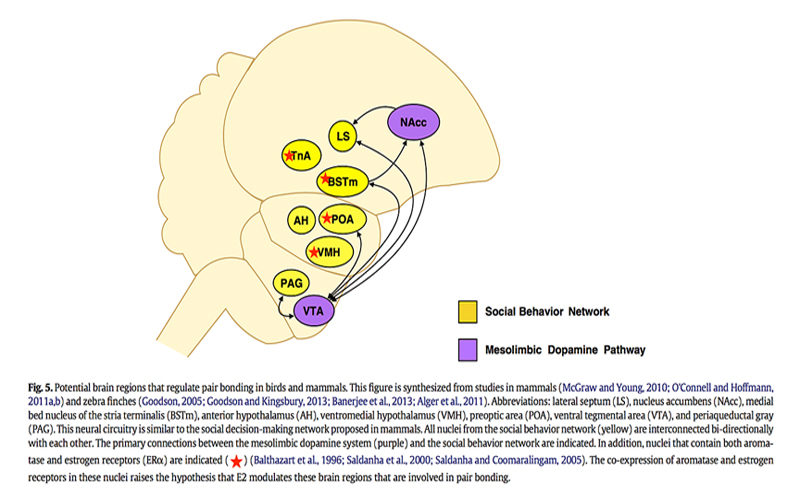

Permission
Nora's fourth grade report, which in an interview she recalled as marking the first "actual learning" she had experienced in school, indexes her affective orientation to animals and her repeated choices to pursue research in this area, a series of choices that ultimately lead to the texts like the Hormones and Behavior review. I would also note that there are also continuities in both textual forms (the kind of mix of text and images that led Lemke [("Multiplying Meaning")] to observe that science writing has long and routinely involved multimedia genres) and composing practices (e.g., drafting text supported by unacknowledged collaborators, what I have called non-authorship [(Writing/Disciplinarity)], as Julie helped type up the jaguarundi paper in fourth grade and I did a round of close copy-editing on a late draft of the Hormones and Behavior article).
In short, how we theorize, study, and represent writing, semiotics, practice, identity, and society matters. The dominant tale of learning codified in the Next Generation Science Standards is deeply problematic. Its linear path of compartmentalized, well-ordered steps offers a startlingly different account from the laminated temporal scale complexity that Lemke invokes to address how moments add up to lives and how our shared moments together add up to social life as such ("Across the Scales of Time").
